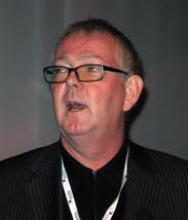GOTHENBURG, SWEDEN – Onychomycosis remains a difficult disorder to treat and cure, even with modern antifungal agents. But the chances of success can be greatly enhanced through application of several proven, evidence-based strategies.
A recent study identified multiple baseline factors associated with a low cure rate following a standard 3-month course of oral terbinafine for onychomycosis. One preemptive strategy in patients possessing several of these poor-prognosis factors is to consider combination therapy from the outset. Alternatively, the standard 3 months of terbinafine could be stretched for 5-6 months, Dr. Bardur Sigurgeirsson said at the annual congress of the European Academy of Dermatology and Venereology.
The host-related prognostic factors were identified in Dr. Sigurgeirsson’s recent secondary retrospective analysis of 3-year outcomes in 199 Icelandic participants in a large international randomized trial of continuous versus intermittent terbinafine (J. Eur. Acad. Dermatol. Venereol. 2010; 24:679-84).
Several of the prognostic factors were already known, but the study provided the first-ever supporting data validating their legitimacy, said Dr. Sigurgeirsson of the University of Iceland, Reykjavik. The new information is particularly useful in everyday clinical practice because no universal classification of disease severity exists.
In the multivariate, logistic, regression analysis, baseline factors associated with a negative outcome at 72 weeks of follow-up – that is, failure to achieve mycologic or clinical cure – included matrix involvement, lateral nail edge involvement, and dermatophytoma. Slow nail growth from screening to baseline was another predictor of lack of cure; this makes sense, as patients with faster-growing nails are likely to shed the infected part sooner, he noted.
Other factors enabling physicians to select good candidates for up-front combination or extended therapy were being over age 65 years, being male, having a history of prior fungal toe infection, and having a positive culture at 24 weeks’ follow-up, even if the nails look good at that point.
Several factors in popular dermatologic lore to predict poor outcome were not borne out in the study. The extent of infection involvement, the number of infected toenails, duration of infection, and presence of spikes were unrelated to the 72-week cure rate. There was a trend for patients with thicker nail plates or subungual hyperkeratosis to be less likely to reach cure, but this factor did not achieve statistical significance, he reported.
The greatest likelihood of cure at 72 weeks’ follow-up after the standard 3 months of oral terbinafine was seen in younger female patients with fast nail growth.
An earlier, randomized, multicenter study by Dr. Sigurgeirsson and coworkers made the case for up-front combination therapy with amorolfine hydrochloride 5% nail lacquer and oral terbinafine for treating onychomycosis in patients with terbinafine monotherapy lack-of-cure risk factors. The trial involved 249 patients; one of the strongest predictors of poor outcome was baseline nail matrix involvement. The success rate at 18 months was 59% for combination therapy, compared with 45% for oral terbinafine monotherapy. The cost per cure was significantly less with combination therapy (Br. J. Dermatol. 2007;157:149-57).
Onychomycosis is best viewed as a chronic relapsing condition, as evidenced by a 5-year, blinded, prospective follow-up study Dr. Sigurgeirsson and colleagues conducted in terbinafine – or itraconazole-treated patients (Arch. Dermatol. 2002;138:353-7). The mycologic relapse rates were 53% in the itraconazole arm and 48% with terbinafine.
In a subsequent study of nearly 4,000 patients, the investigators identified a number of risk factors for recurrent onychomycosis: cancer, 3.4-fold increased risk; psoriasis, 2.4-fold increased risk; tinea pedis interdigitalis, 3.9-fold increased risk; moccasin form of tinea pedis, 4.3-fold increased risk; regular swimming, 2.6-fold increased risk; and having a spouse, parents, or children with onychomycosis, 2.5- to 3.5-fold increased risk (J. Eur. Acad. Dermatol. Venereol. 2004;18:48-51).
These findings were recently confirmed and expanded upon in a Japanese survey of 30,000 dermatology patients. Dermatologists at Teikyo University in Itabashi found most of the same risk factors earlier identified by Dr. Sigurgeirsson and coworkers. In addition, the Japanese investigators identified two previously undescribed risk factors for recurrent infection: more time spent wearing shoes, and having a higher temperature in the home (J. Dermatol. 2010;37:397-406).
Prophylactic therapy is worth considering following cure of onychomycosis in patients at increased risk for relapse based upon their risk factor profile, Dr. Sigurgeirsson said. He and his coworkers recently showed that amorolfine nail lacquer applied once every 2 weeks is safe and effective for this purpose (J. Eur. Acad. Dermatol. Venereol. 2010;24:910-5).
Many of his studies of terbinafine for onychomycosis were supported by research grants from Novartis.



